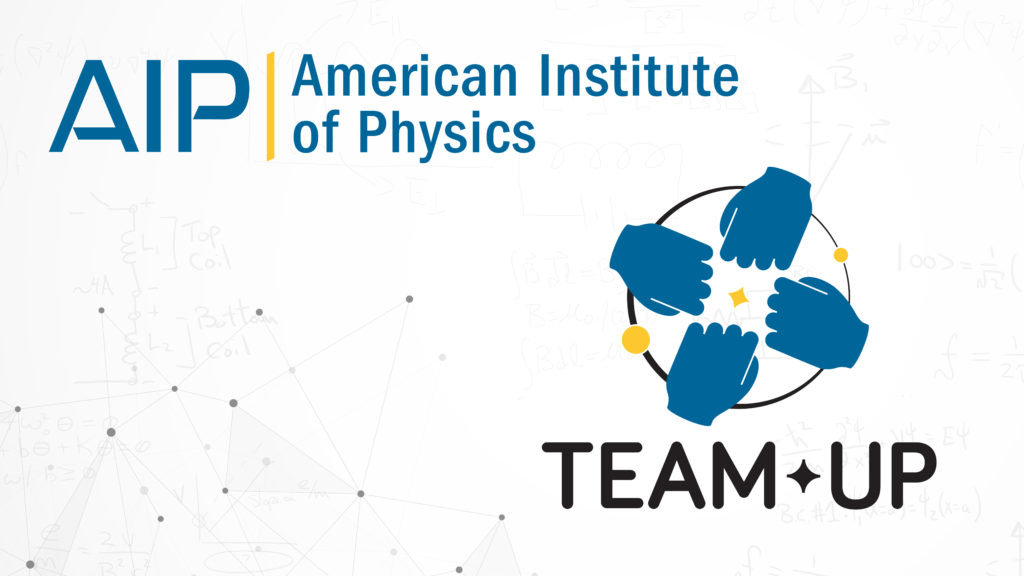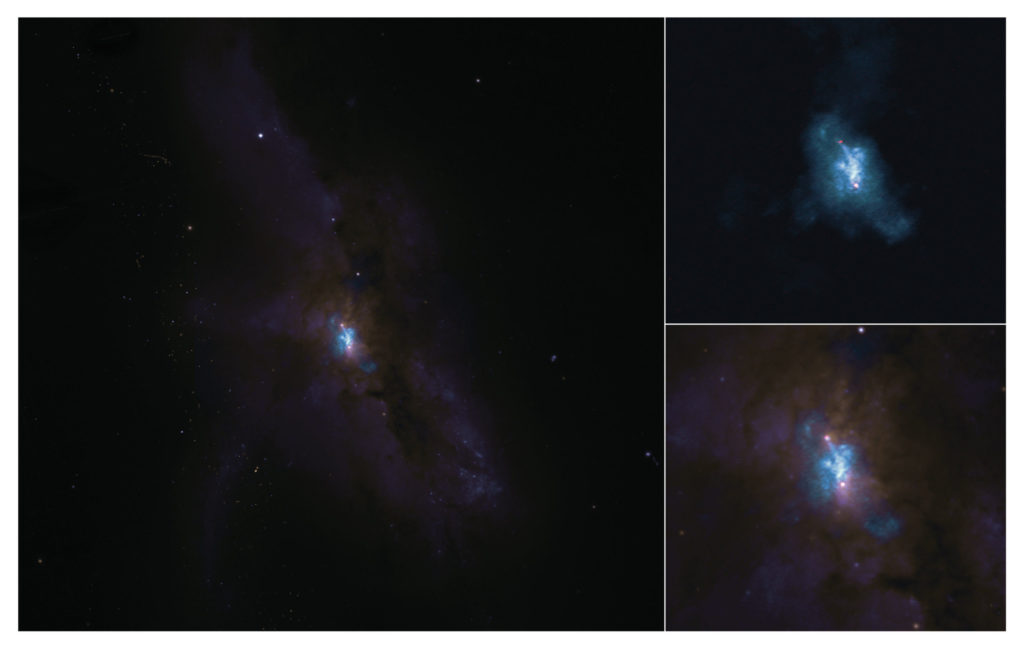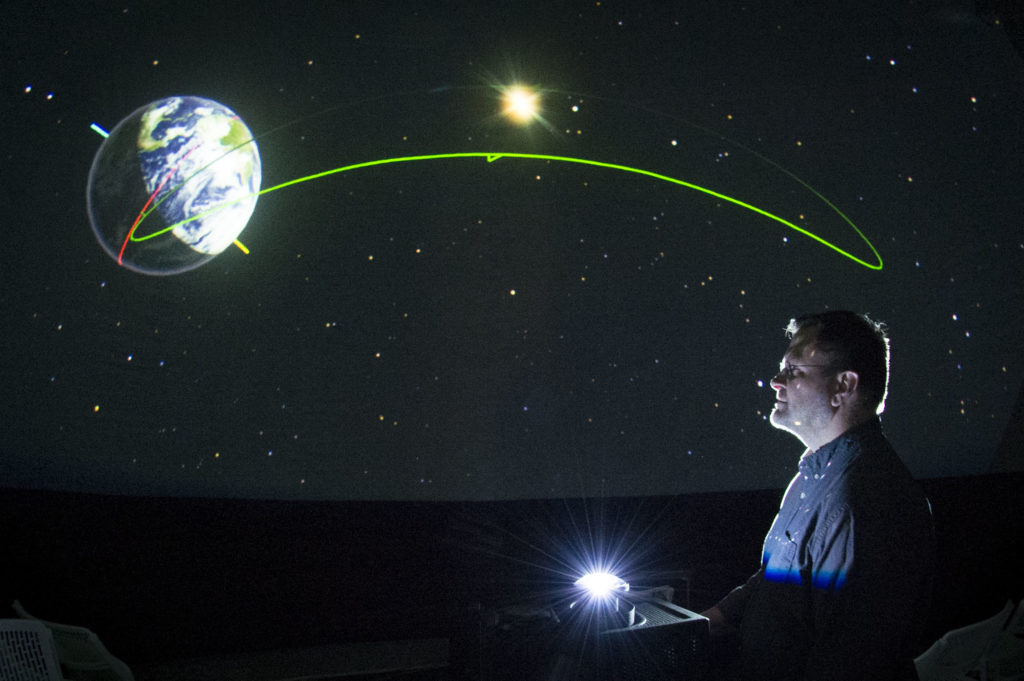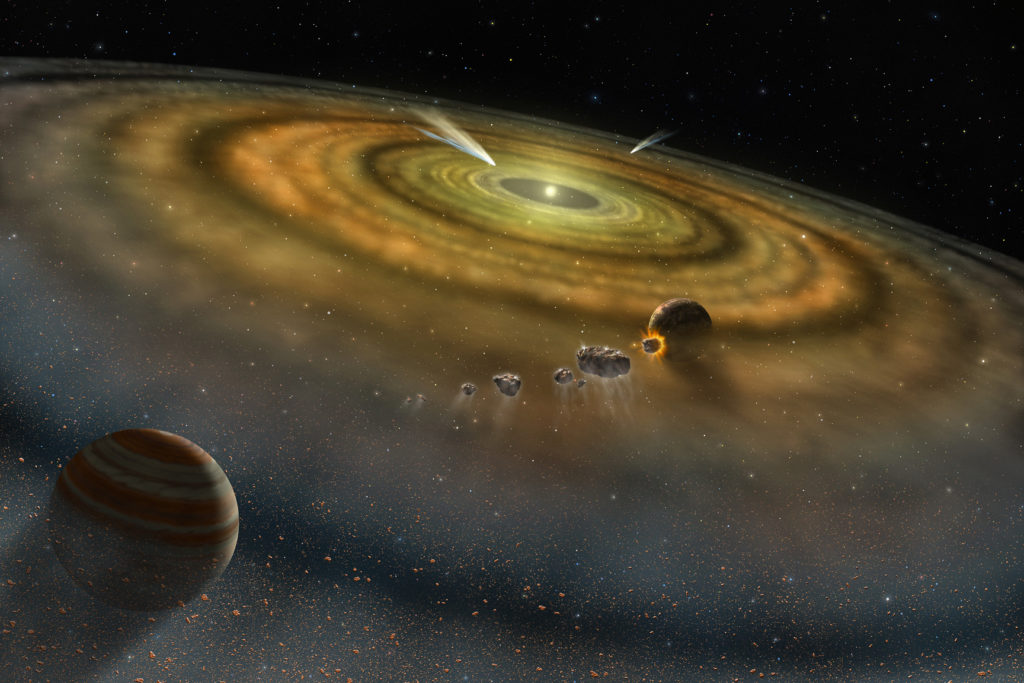LSU astronomy researchers estimate the peak of brightness and explosion of luminous star brighter than any other in the Milky Way Galaxy
Tag: Astronomy
Cosmic bubbles reveal the first stars
Astronomers detect first stars ‘bubbling out’ from the cosmic dark ages
First national US observatory to be named after a woman!
It was announced today that the upcoming Large Synoptic Survey Telescope (LSST), which will conduct a vast astronomical survey for unprecedented discovery of the deep and dynamic Universe, will now be named the NSF (National Science Foundation) Vera C. Rubin…
New map of Milky Way reveals giant wave of stellar nurseries
Interconnected stellar nurseries form the largest gaseous structure ever observed in the Milky Way galaxy
NASA’s TESS mission uncovers its first world with two stars
In 2019, when Wolf Cukier finished his junior year at Scarsdale High School in New York, he joined NASA’s Goddard Space Flight Center in Greenbelt, Maryland, as a summer intern. His job was to examine variations in star brightness captured…
SDSU astronomers pinpoint two new ‘Tatooine’ planetary systems
Astronomers announced Monday the first discovery made by NASA’s TESS mission of a two-star planetary system. Led by researchers at NASA’s Goddard Space Flight Center and San Diego State University, with other collaborators, the telescope satellite’s finding marks the start…
A fast radio burst tracked down to a nearby galaxy
Astronomers in Europe, working with members of Canada’s CHIME Fast Radio Burst collaboration, have pinpointed the location of a repeating fast radio burst (FRB) first detected by the CHIME telescope in British Columbia in 2018. The breakthrough is only the…
Astronomers spot distant galaxy group driving ancient cosmic makeover
An international team of astronomers funded in part by NASA has found the farthest galaxy group identified to date. Called EGS77, the trio of galaxies dates to a time when the universe was only 680 million years old, or less…
NASA’s great observatories help astronomers build a 3D visualization of an exploded star
Astronomers and visualization specialists from NASA’s Universe of Learning program have combined the visible, infrared and X-ray vision of NASA’s Great Observatories to create a three-dimensional representation of the dynamic Crab Nebula, the tattered remains of an exploded star. The…
Simulated image demonstrates the power of NASA’s wide field infrared survey telescope
Imagine a fleet of 100 Hubble Space Telescopes, deployed in a strategic space-invader-shaped array a million miles from Earth, scanning the universe at warp speed. With NASA’s Wide Field Infrared Survey Telescope, scheduled for launch in the mid-2020s, this vision…
Scientists develop new method to detect oxygen on exoplanets
Technique could speed search for life in outer space
In a nearby galaxy, a fast radio burst unravels more questions than answers
For more than a decade, astronomers across the globe have wrestled with the perplexities of fast radio bursts — intense, unexplained cosmic flashes of energy, light years away, that pop for mere milliseconds. Despite the hundreds of records of these…
Surprise! TESS shows ancient north star undergoes eclipses
Astronomers using data from NASA’s Transiting Exoplanet Survey Satellite (TESS) have shown that Alpha Draconis, a well-studied star visible to the naked eye, and its fainter companion star regularly eclipse each other. While astronomers previously knew this was a binary…
A fast radio burst tracked down to a nearby galaxy
Astronomers in Europe, working with members of Canada’s CHIME Fast Radio Burst collaboration, have pinpointed the location of a repeating fast radio burst (FRB) first detected by the CHIME telescope in British Columbia in 2018. The breakthrough is only the…
Astronomers spot distant galaxy group driving ancient cosmic makeover
An international team of astronomers funded in part by NASA has found the farthest galaxy group identified to date. Called EGS77, the trio of galaxies dates to a time when the universe was only 680 million years old, or less…
NASA’s great observatories help astronomers build a 3D visualization of an exploded star
Astronomers and visualization specialists from NASA’s Universe of Learning program have combined the visible, infrared and X-ray vision of NASA’s Great Observatories to create a three-dimensional representation of the dynamic Crab Nebula, the tattered remains of an exploded star. The…
Simulated image demonstrates the power of NASA’s wide field infrared survey telescope
Imagine a fleet of 100 Hubble Space Telescopes, deployed in a strategic space-invader-shaped array a million miles from Earth, scanning the universe at warp speed. With NASA’s Wide Field Infrared Survey Telescope, scheduled for launch in the mid-2020s, this vision…
Scientists develop new method to detect oxygen on exoplanets
Technique could speed search for life in outer space
In a nearby galaxy, a fast radio burst unravels more questions than answers
For more than a decade, astronomers across the globe have wrestled with the perplexities of fast radio bursts — intense, unexplained cosmic flashes of energy, light years away, that pop for mere milliseconds. Despite the hundreds of records of these…

Task Force Recommendations Outline Changes Needed to Increase African American Physics and Astronomy Students
Due to long-term and systemic issues leading to the consistent exclusion of African Americans in physics and astronomy, a task force is recommending sweeping changes and calling for awareness into the number and experiences of African American students studying the fields. “The Time Is Now: Systemic Changes to Increase African Americans with Bachelor’s Degrees in Physics and Astronomy” discusses the factors responsible for the success or failure of African American students in physics and astronomy.

The Turbulent Life of Two Supermassive Black Holes Caught in a Galaxy Crash
An international team of astronomers used the Atacama Large Millimeter/submillimeter Array (ALMA) to create the most detailed image yet of the gas surrounding two supermassive black holes in a merging galaxy.
IKBFU astrophysicists have developed a theory explaining the ‘Dark Energy’ phenomenon
The fact that our Universe is expanding was discovered almost a hundred years ago, but how exactly this happens, scientists realized only in the 90s of the last century, when powerful telescopes (including orbital ones) appeared and the era of exact cosmo
Massive gas disk raises questions about planet formation theory
Astronomers using the Atacama Large Millimeter/submillimeter Array (ALMA) found a young star surrounded by an astonishing mass of gas. The star, called 49 Ceti, is 40 million years old and conventional theories of planet formation predict that the gas should…

Buffalo State Earth Sciences expert available to speak about the Winter Solstice
Tired of the dark, seemingly shorter days? You’re in luck. Starting December 22, the amount of sunlight in a day starts to creep back up. But what happens on December 21, the first day of winter? That’s the winter solstice,…
Asteroid collisions trigger cascading formation of subfamilies, study concludes
Scientists have always thought about fission clusters as entirely distinct from collisional families. Now a study conducted by researchers affiliated with UNESP has shown that fission clusters may originate from collisional families in some cases
ESO observations reveal black holes’ breakfast at the cosmic dawn
Astronomers using ESO’s Very Large Telescope have observed reservoirs of cool gas around some of the earliest galaxies in the Universe. These gas halos are the perfect food for supermassive black holes at the centre of these galaxies, which are…
Astronomers reveal new image of candy cane-shaped feature in the center of our galaxy
A team of astronomers has produced a new image of an arc-shaped object in the center of our Milky Way galaxy. The feature, which resembles a candy cane, is a magnetic structure that covers an enormous region of some 160…
NASA’s Fermi Mission links nearby pulsar’s gamma-ray ‘halo’ to antimatter puzzle
NASA’s Fermi Gamma-ray Space Telescope has discovered a faint but sprawling glow of high-energy light around a nearby pulsar. If visible to the human eye, this gamma-ray “halo” would appear about 40 times bigger in the sky than a full…
Asteroid collisions trigger cascading formation of subfamilies, study concludes
Scientists have always thought about fission clusters as entirely distinct from collisional families. Now a study conducted by researchers affiliated with UNESP has shown that fission clusters may originate from collisional families in some cases
NASA’s Fermi Mission links nearby pulsar’s gamma-ray ‘halo’ to antimatter puzzle
NASA’s Fermi Gamma-ray Space Telescope has discovered a faint but sprawling glow of high-energy light around a nearby pulsar. If visible to the human eye, this gamma-ray “halo” would appear about 40 times bigger in the sky than a full…
ESO observations reveal black holes’ breakfast at the cosmic dawn
Astronomers using ESO’s Very Large Telescope have observed reservoirs of cool gas around some of the earliest galaxies in the Universe. These gas halos are the perfect food for supermassive black holes at the centre of these galaxies, which are…
Astronomers reveal new image of candy cane-shaped feature in the center of our galaxy
A team of astronomers has produced a new image of an arc-shaped object in the center of our Milky Way galaxy. The feature, which resembles a candy cane, is a magnetic structure that covers an enormous region of some 160…
New space image reveals cosmic ‘candy cane’
Center of milky way galaxy stitched together by new wavelength data
NASA’s GISMO instrument maps inner Milky Way, sees cosmic ‘candy cane’
A feature resembling a candy cane appears at the center of this colorful composite image of our Milky Way galaxy’s central zone. But this is no cosmic confection. It spans 190 light-years and is one of a set of long,…
New clues on dark matter from the darkest galaxies
A study by SISSA provides important information on its composition and on its interaction with luminous matter
New space image reveals cosmic ‘candy cane’
Center of milky way galaxy stitched together by new wavelength data
NASA’s GISMO instrument maps inner Milky Way, sees cosmic ‘candy cane’
A feature resembling a candy cane appears at the center of this colorful composite image of our Milky Way galaxy’s central zone. But this is no cosmic confection. It spans 190 light-years and is one of a set of long,…
New clues on dark matter from the darkest galaxies
A study by SISSA provides important information on its composition and on its interaction with luminous matter
The ‘cores’ of massive galaxies had already formed 1.5 billion years after the big bang
A distant galaxy more massive than our Milky Way – with more than a trillion stars – has revealed that the ‘cores’ of massive galaxies in the Universe had formed already 1.5 billion years after the Big Bang, about 1…
RIT and IAR observe pulsars for the first time from South America
Upgraded radio telescopes enable scientists to study pulsars from the southern hemisphere
Carbon cocoons surround growing galaxies far beyond previous beliefs
Researchers have discovered gigantic clouds of gaseous carbon spanning more than a radius of 30,000 light-years around young galaxies using the Atacama Large Millimeter/submillimeter Array (ALMA) in Chile. This is the first confirmation that carbon atoms produced inside of stars…
100,000s of people select names for exoplanet systems
On 17 December 2019 the names of 112 sets of exoplanets and host stars named in the IAU100 NameExoWorlds campaigns were announced at a press conference in Paris (France). Within the framework of the International Astronomical Union’s 100th anniversary commemorations…
NASA’s SDO sees new kind of magnetic explosion on sun
NASA’s Solar Dynamics Observatory has observed a magnetic explosion the likes of which have never been seen before. In the scorching upper reaches of the Sun’s atmosphere, a prominence — a large loop of material launched by an eruption on…
RIT and IAR observe pulsars for the first time from South America
Upgraded radio telescopes enable scientists to study pulsars from the southern hemisphere
Carbon cocoons surround growing galaxies far beyond previous beliefs
Researchers have discovered gigantic clouds of gaseous carbon spanning more than a radius of 30,000 light-years around young galaxies using the Atacama Large Millimeter/submillimeter Array (ALMA) in Chile. This is the first confirmation that carbon atoms produced inside of stars…
100,000s of people select names for exoplanet systems
On 17 December 2019 the names of 112 sets of exoplanets and host stars named in the IAU100 NameExoWorlds campaigns were announced at a press conference in Paris (France). Within the framework of the International Astronomical Union’s 100th anniversary commemorations…
NASA’s SDO sees new kind of magnetic explosion on sun
NASA’s Solar Dynamics Observatory has observed a magnetic explosion the likes of which have never been seen before. In the scorching upper reaches of the Sun’s atmosphere, a prominence — a large loop of material launched by an eruption on…

Meteorites lend clues to origins of earliest history of solar system
Lawrence Livermore National Laboratory (LLNL) scientists and a collaborator from the University of Münster reviewed recent work that shows how meteorites exhibit a fundamental isotopic dichotomy between non-carbonaceous (NC) and carbonaceous (CC – rocks or sediments containing carbon or its compounds) groups, which most likely represent material from the inner and outer solar system.
ESO telescope images stunning central region of Milky Way, finds ancient star burst
ESO’s Very Large Telescope (VLT) has observed the central part of the Milky Way with spectacular resolution and uncovered new details about the history of star birth in our galaxy. Thanks to the new observations, astronomers have found evidence for…
$1M Schmidt Futures grant awarded to accelerate computer modeling of the cosmos at IAS
James M. Stone, professor of computational astrophysics at the Institute for Advanced Study, heads IAS project on the Dynamics of Neutron Star Mergers, Star & Planet Formation, and the Interstellar Medium